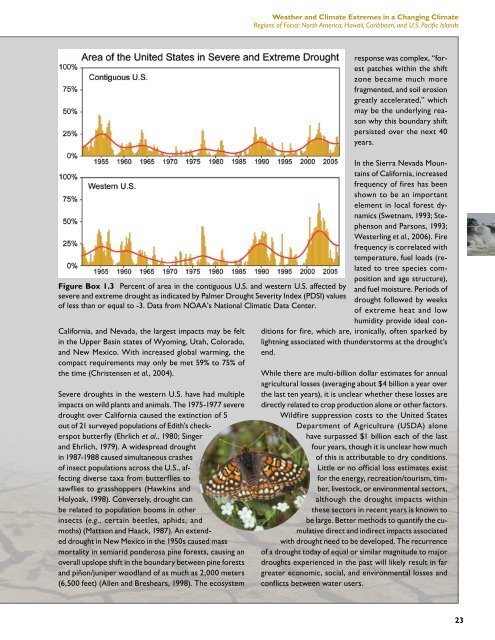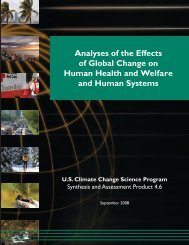Weather and Climate Extremes in a Changing Climate. Regions of ...
Weather and Climate Extremes in a Changing Climate. Regions of ...
Weather and Climate Extremes in a Changing Climate. Regions of ...
Create successful ePaper yourself
Turn your PDF publications into a flip-book with our unique Google optimized e-Paper software.
Figure Box 1.3 Percent <strong>of</strong> area <strong>in</strong> the contiguous U.S. <strong>and</strong> western U.S. affected by<br />
severe <strong>and</strong> extreme drought as <strong>in</strong>dicated by Palmer Drought Severity Index (PDSI) values<br />
<strong>of</strong> less than or equal to -3. Data from NOAA’s National Climatic Data Center.<br />
California, <strong>and</strong> Nevada, the largest impacts may be felt<br />
<strong>in</strong> the Upper Bas<strong>in</strong> states <strong>of</strong> Wyom<strong>in</strong>g, Utah, Colorado,<br />
<strong>and</strong> New Mexico. With <strong>in</strong>creased global warm<strong>in</strong>g, the<br />
compact requirements may only be met 59% to 75% <strong>of</strong><br />
the time (Christensen et al., 2004).<br />
Severe droughts <strong>in</strong> the western U.S. have had multiple<br />
impacts on wild plants <strong>and</strong> animals. The 1975-1977 severe<br />
drought over California caused the ext<strong>in</strong>ction <strong>of</strong> 5<br />
out <strong>of</strong> 21 surveyed populations <strong>of</strong> Edith’s checkerspot<br />
butterfly (Ehrlich et al., 1980; S<strong>in</strong>ger<br />
<strong>and</strong> Ehrlich, 1979). A widespread drought<br />
<strong>in</strong> 1987-1988 caused simultaneous crashes<br />
<strong>of</strong> <strong>in</strong>sect populations across the U.S., affect<strong>in</strong>g<br />
diverse taxa from butterflies to<br />
sawflies to grasshoppers (Hawk<strong>in</strong>s <strong>and</strong><br />
Holyoak, 1998). Conversely, drought can<br />
be related to population booms <strong>in</strong> other<br />
<strong>in</strong>sects (e.g., certa<strong>in</strong> beetles, aphids, <strong>and</strong><br />
moths) (Mattson <strong>and</strong> Haack, 1987). An extended<br />
drought <strong>in</strong> New Mexico <strong>in</strong> the 1950s caused mass<br />
mortality <strong>in</strong> semiarid ponderosa p<strong>in</strong>e forests, caus<strong>in</strong>g an<br />
overall upslope shift <strong>in</strong> the boundary between p<strong>in</strong>e forests<br />
<strong>and</strong> piñon/juniper woodl<strong>and</strong> <strong>of</strong> as much as 2,000 meters<br />
(6,500 feet) (Allen <strong>and</strong> Breshears, 1998). The ecosystem<br />
<strong>Weather</strong> <strong>and</strong> <strong>Climate</strong> <strong>Extremes</strong> <strong>in</strong> a Chang<strong>in</strong>g <strong>Climate</strong><br />
<strong>Regions</strong> <strong>of</strong> Focus: North America, Hawaii, Caribbean, <strong>and</strong> U.S. Pacific Isl<strong>and</strong>s<br />
response was complex, “forest<br />
patches with<strong>in</strong> the shift<br />
zone became much more<br />
fragmented, <strong>and</strong> soil erosion<br />
greatly accelerated,” which<br />
may be the underly<strong>in</strong>g reason<br />
why this boundary shift<br />
persisted over the next 40<br />
years.<br />
In the Sierra Nevada Mounta<strong>in</strong>s<br />
<strong>of</strong> California, <strong>in</strong>creased<br />
frequency <strong>of</strong> fires has been<br />
shown to be an important<br />
element <strong>in</strong> local forest dynamics<br />
(Swetnam, 1993; Stephenson<br />
<strong>and</strong> Parsons, 1993;<br />
Westerl<strong>in</strong>g et al., 2006). Fire<br />
frequency is correlated with<br />
temperature, fuel loads (related<br />
to tree species composition<br />
<strong>and</strong> age structure),<br />
<strong>and</strong> fuel moisture. Periods <strong>of</strong><br />
drought followed by weeks<br />
<strong>of</strong> extreme heat <strong>and</strong> low<br />
humidity provide ideal conditions<br />
for fire, which are, ironically, <strong>of</strong>ten sparked by<br />
lightn<strong>in</strong>g associated with thunderstorms at the drought’s<br />
end.<br />
While there are multi-billion dollar estimates for annual<br />
agricultural losses (averag<strong>in</strong>g about $4 billion a year over<br />
the last ten years), it is unclear whether these losses are<br />
directly related to crop production alone or other factors.<br />
Wildfire suppression costs to the United States<br />
Department <strong>of</strong> Agriculture (USDA) alone<br />
have surpassed $1 billion each <strong>of</strong> the last<br />
four years, though it is unclear how much<br />
<strong>of</strong> this is attributable to dry conditions.<br />
Little or no <strong>of</strong>ficial loss estimates exist<br />
for the energy, recreation/tourism, timber,<br />
livestock, or environmental sectors,<br />
although the drought impacts with<strong>in</strong><br />
these sectors <strong>in</strong> recent years is known to<br />
be large. Better methods to quantify the cumulative<br />
direct <strong>and</strong> <strong>in</strong>direct impacts associated<br />
with drought need to be developed. The recurrence<br />
<strong>of</strong> a drought today <strong>of</strong> equal or similar magnitude to major<br />
droughts experienced <strong>in</strong> the past will likely result <strong>in</strong> far<br />
greater economic, social, <strong>and</strong> environmental losses <strong>and</strong><br />
conflicts between water users.<br />
23




